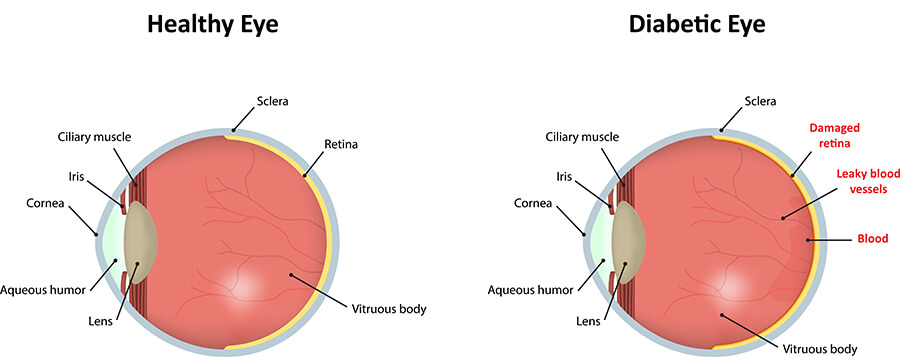Did you know that over 40% of people with diabetes develop some stage of diabetic retinopathy?
If you or a loved one lives in the Inland Empire and has diabetes, this is something you shouldn’t ignore.
At Pacific Eye Institute, we understand how confusing it can be to manage your vision and overall health, especially during the hot summer months when extreme temperatures can actually worsen your risk of diabetic eye disease.
In this comprehensive guide, we’ll break down what diabetic retinopathy is, what causes it, how to recognize early symptoms, how the intense July heat can impact your risk, and the treatment options available to protect your sight for years to come.
What Is Diabetic Retinopathy?
Diabetic retinopathy is an eye condition that affects the retina — the light-sensitive tissue at the back of your eye. Over time, high blood sugar levels from diabetes can damage the tiny blood vessels in the retina, leading to vision loss if left untreated.
According to the American Academy of Ophthalmology (AAO), diabetic retinopathy is the leading cause of blindness among working-age adults in the U.S. The good news? Early detection and timely treatment can reduce the risk of blindness by 95%.

“One of the most important conditions we see is diabetic eye disease. It’s crucial for patients with diabetes to be screened regularly and treated appropriately — whether that’s with medicine injections, laser treatments, or careful monitoring. Diabetic retinopathy is a significant public health concern, and early detection truly makes a difference in preserving vision.”
— Dr. Rudometkin, Retina Specialist at Pacific Eye Institute
Why Inland Empire Residents Should Be Extra Cautious This Summer?
July brings soaring temperatures to the Inland Empire. Did you know that:
- Extreme heat can cause dehydration, which makes blood sugar levels harder to control.
- Heat stress can lead to spikes or drops in blood sugar, both of which can worsen diabetic retinopathy.
- According to the Centers for Disease Control and Prevention (CDC), staying hydrated and monitoring your blood sugar closely in hot weather is essential for preventing complications.
So while you’re enjoying sunny days in Rancho Cucamonga, Upland, or the greater Inland Empire, remember — your eyes need protection too.
What Causes Diabetic Retinopathy?
Several factors can contribute to the development and progression of diabetic retinopathy:
- Uncontrolled Blood Sugar: Persistently high glucose levels damage retinal blood vessels.
- High Blood Pressure: Increases stress on your eyes’ delicate vessels.
- High Cholesterol: Can contribute to blood vessel blockages.
- Duration of Diabetes: The longer you have diabetes, the higher your risk.
- Pregnancy: Gestational diabetes can also increase your risk.

Recognizing the Symptoms of Diabetic Retinopathy
Diabetic retinopathy often starts with no noticeable symptoms, which is why it’s so dangerous. As the disease progresses, you may experience:
- Blurred or fluctuating vision
- Dark or empty spots in your vision (floaters)
- Difficulty seeing at night
- Colors appearing faded or washed out
- Sudden vision loss in severe cases
When Should You See an Eye Doctor?
If you notice any changes in your vision — even subtle ones — don’t wait. Diabetic retinopathy can progress silently, so early detection is your best defense.
At Pacific Eye Institute, you’ll be cared for by our highly trained retina specialists who have extensive experience in diagnosing and treating diabetic eye conditions. Our retina doctors use the latest diagnostic imaging and treatment options to help you protect your sight and quality of life.
Treatment Options for Diabetic Retinopathy
The right treatment plan depends on the stage of your disease and your overall eye health. Here are some options we offer at Pacific Eye Institute:
1. Controlling Blood Sugar and Overall Health – The foundation of managing diabetic retinopathy is good diabetes control:
- Monitor your A1C levels
- Eat a balanced diet
- Exercise regularly
- Stay hydrated, especially during the Diabetic Retinopathy Inland EmpireInland Empire’s summer months
2. Medications (Anti-VEGF Injections) – These medications reduce swelling and stop abnormal blood vessels from growing in the retina.
3. Laser Treatment – Laser therapy can seal leaking blood vessels or shrink abnormal ones, preventing further damage.
4. Vitrectomy Surgery – For advanced cases, surgery may be needed to remove blood and scar tissue from the eye to restore clearer vision.
Conclusion
Your eyes deserve the best care, and your future vision depends on what you do today. Remember, diabetic retinopathy often has no early warning signs, so don’t wait until your sight is at risk.
If you live in Rancho Cucamonga, Upland, or anywhere in the Inland Empire, the experienced retina specialists at Pacific Eye Institute are here to help you protect your sight with personalized, comprehensive care. Concerned about diabetic retinopathy? Click below to schedule an eye exam with Pacific Eye Institute today or call (800) 345-8979.
Here’s what our patients are saying about our Retina Specialist:
“My visit with Dr. Ng yesterday was fabulous. During my visit, he diagnosed additional, serious problems with my eye and ordered immediate emergency surgery, which was performed promptly nearby. I’m now recovering at home with little or no sight problems. I am confident in Dr Ng’s professionalism and diligent performance with my eye care.”
“I found out I had a torn retina on Monday and was having surgery with Dr. Samuel Kim by Wednesday morning. My surgery was so much easier and stress free than I expected. Everyone from the Colton to the Eastvale to the Upland offices has been so nice. Dr. Kim made me feel safe and confident I was in good hands. With the state of health care today, it’s amazing to be cared for by Pacific Eye Institute.”








